What Are Positive Parenting Techniques?
So, you’ve read articles on “How to raise a happy child” and “What are positive parenting techniques?” You’ve probably been asking yourself the same questions: how do I give my child a break from discipline? In this article, you’ll learn how to set limits, encourage good behavior, and enforce consequences in a firm but fair manner. And you’ll learn about time-outs. But what are these techniques?
Setting limits
Set limits for your children. Limits give kids a sense of security and are like an emotional structure for them. Children must be taught to respect limits or face consequences. The key to setting limits is consistency. Parents should always remain calm when communicating the limits with their children. It’s important to communicate a sense of empathy and avoid the temptation to use punitive measures. Regardless of how your child reacted to the limits you set, it’s important to be consistent.
Parents often use reaction limit setting when their children act inappropriately. When their young children crawl towards a hot stove, they react by getting them out of the way. This reaction limit setting strategy works well with small children, but is not a good choice for teens or adults. Setting limits for your child should be done thoughtfully and lovingly, as this will help them develop self-respect. It also helps your child understand that they can’t do everything they want.
Children hate bumping into limits, so they must be able to recover from this before trying again. Having a plan for the future is helpful, but make sure to stick to it. Keeping your boundaries can also make kids feel safe. Your child will feel secure and loved by you if you make them respect their boundaries. If they’ve accidentally bumped their heads into limits, they will likely be very upset and may not be ready to face their consequences.
Encouraging good behavior
One of the core components of positive parenting is praise. Praise is a powerful social-emotional tool for children, enabling them to build healthy relationships and learn to relate to others. Children often seek validation from their parents, and praise is a form of this. Praising good behavior motivates your child to repeat it, rather than focusing on mistakes. Punishment, on the other hand, can encourage undesirable behaviors.
In addition to praise, one of the most effective discipline strategies is to establish an emotional connection with your child. It is essential to maintain a close bond with your child, and punishment destroys the relationship. Instead, use loving guidance to set limits and reinforce expectations in a manner that strengthens the relationship with your child. This helps your child focus on improving behavior instead of focusing on your disapproval. Even setting boundaries should be done with empathy, so your child will feel safe and understand why they’re doing it.
Positive parenting also helps teachers improve classroom behavior. By replacing punitive discipline policies with supportive problem-solving, middle school teachers can encourage students to behave better. Additionally, this approach can protect children from toxic stress, leading to better health outcomes and fewer brain abnormalities associated with stress. These parenting techniques are an excellent way to help bring out the best in your child. So, how can you make the most of positive parenting techniques?
Enforcing consequences in a kind and firm way
The key to enforcing consequences in a type of positive parenting is to make sure you do not confuse kindness with permissiveness. Showing kindness without firmness sends a message of entitlement to children and erodes their respect for you. Be firm, but kind, and your child will respect you more. In this way, your child will not feel bad about making you angry or hurt.
When enforcing consequences, be sure to choose those that are aimed at the wrong behavior and based on the child’s level of understanding. For example, if your child stays out past curfew, you might want to consider giving him a letter of apology, which must also include what he will do differently next time. However, if your child gets angry or hurt by the consequences, be firm and calm.
In addition to the type of consequences you use, you should consider the tone of your voice. Being firm but kind is a good balance. Decide what rules are important to your child, communicate them to him or her, and then enforce them in a way that makes them understand. Positive parenting techniques don’t involve allowing your child to walk all over you. It simply means that you have a calm tone when your child needs a reminder.
Time-outs
A time-out is a punishment for misbehavior that is intended to stop your child from continuing the behavior. It is generally not fun for your child and does not allow them to interact with others. Children may feel like they’ve been “banished” from your household if they’re left to their own devices or to stay away from certain areas of the house. A time-out is often considered an effective positive parenting technique because it works!
While a time-out can be an effective tool in controlling problem behaviors, it should not be overused. Research has shown that a timeout can have a positive effect within the first minute or two. If you allow more time, it may only satisfy your child’s sense of justice and might not change the behavior at all. Therefore, the time-out should be a part of a discipline plan that focuses on the desired behavior.
The time-out should be brief, but if it is too long, it may lead your child to forget its purpose and may even feel resentful. To help your child understand that time-outs can only be positive when you are calm, it’s best to take several deep breaths before you react. You may want to consider discussing the rules of your household with your child rather than yelling at them for doing something wrong.
Empathy
Parents who practice empathy with their children can influence their child’s development. Inhibited temperament is associated with lower levels of empathy in children. Inhibited temperaments have a deficit in empathy, but they understand other people’s distress and seem unable to respond appropriately. Parenting behaviors that promote empathy in children may be more effective than those that inhibit their child’s emotions. Empathy training has many benefits, but it is not for everyone.
Developing empathy in children can make them more compassionate people. It can help them resolve conflicts effectively and dissolve needless boundaries. Furthermore, it helps children form stronger friendships and become more resilient. But it takes years to develop empathy in a child, so parents must be patient. Empathy is a valuable parenting technique, but there are several ways to teach it. Reading to your child can help your child develop empathy. Reading books with diverse characters will expose your child to different experiences and encourage a sense of understanding.
The age of a child may play a role in the level of empathy a child displays. For example, newborns may be unable to regulate their emotions and sensitivity. However, in the first few months of life, caregivers’ responsiveness and emotion socialization styles may affect the development of empathy in a child. Interestingly, this factor may account for more variance in the child’s empathy than vocabulary.
Meditation
Meditation can help parents calm their kids. This practice helps children learn self-regulation, reduces stress, and promotes mindful parenting. It is especially useful for older kids, who can reason out their misbehavior. For example, if your child breaks a toy, he or she cannot play with it anymore. This way, they won’t be so quick to lash out. However, if your child is young, they can still rationalize the behavior.
In addition to helping kids become more conscious, meditation can also help them fall asleep. It’s particularly helpful for night owls. While kids are usually unable to get a full night’s rest, you can model this practice and help your kids become more mindful. Try to get enough shut-eye yourself. And don’t forget to take turns meditating! Your kids will thank you! Just make sure that you don’t do this during naptime!
The practice of mindfulness is an excellent tool for parents who are overwhelmed or need a little break from their hectic schedule. By focusing on the present moment and breathing, parents can develop a more flexible approach to their child’s problems. With this approach, parents can think of solutions that will benefit them. And don’t worry, mindfulness isn’t a magical cure-all; it’s a mental and emotional fitness practice that can help them manage a wide range of emotions.




